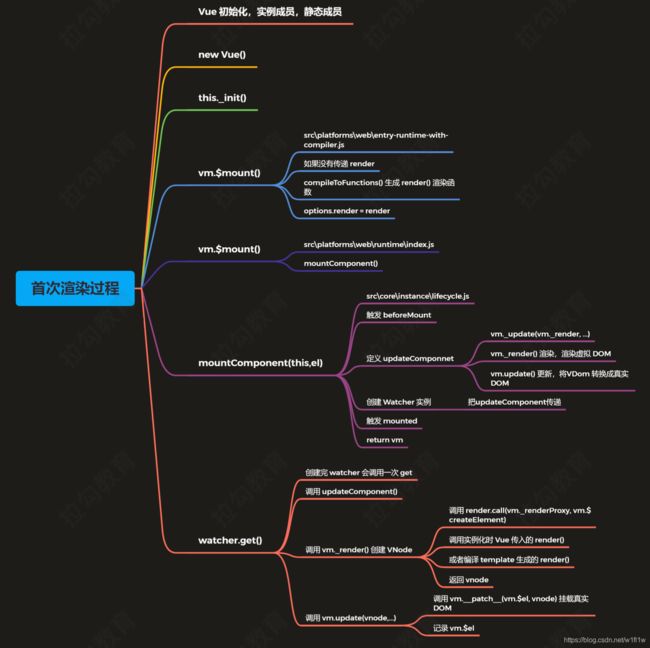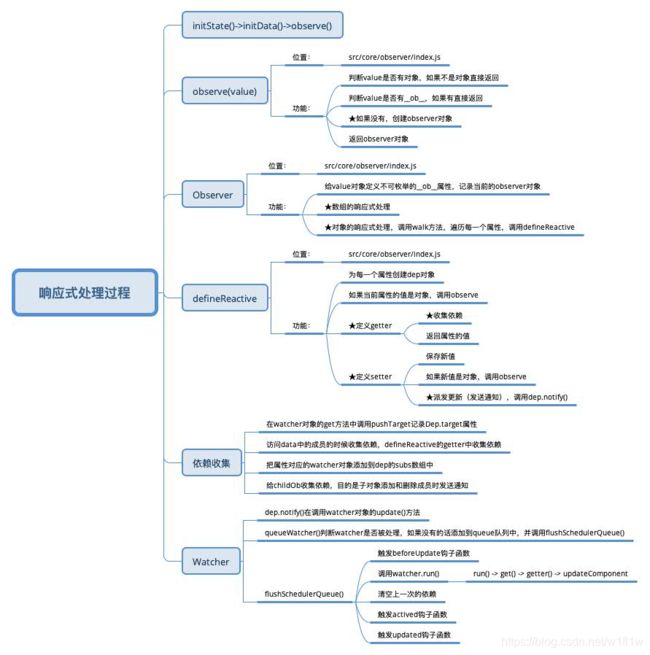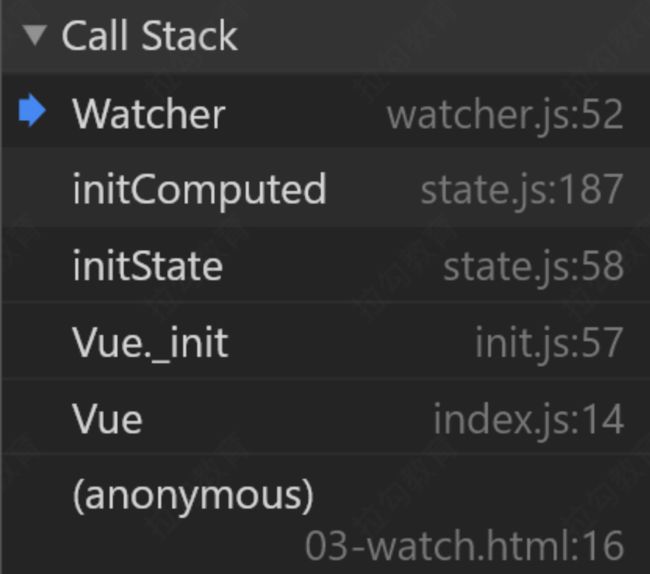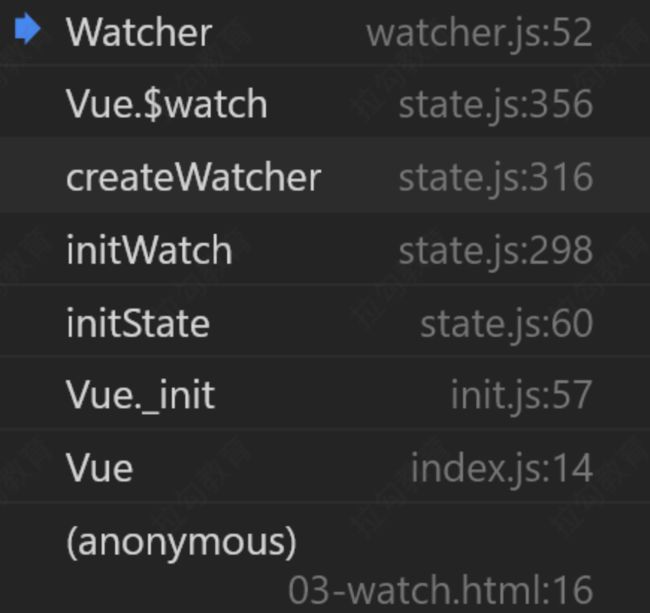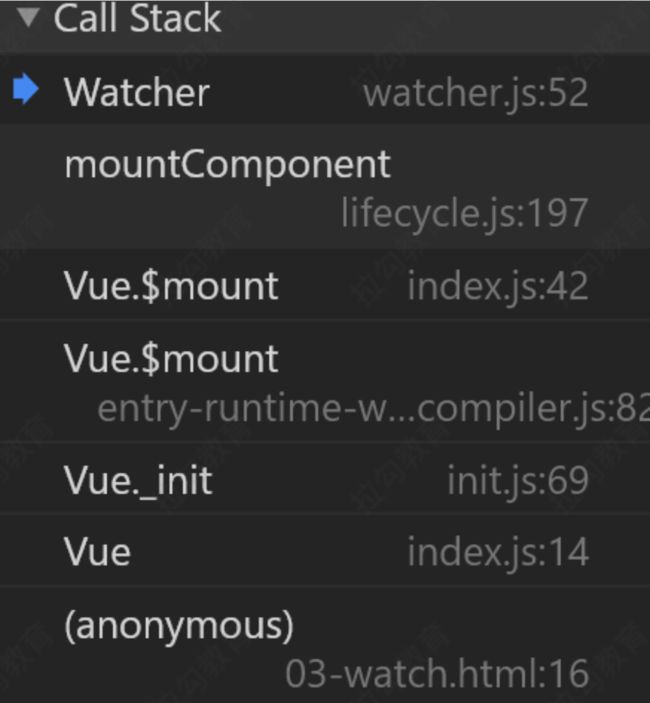8.2.1 Vue.js 源码剖析-响应式原理
本文为拉勾网大前端高薪训练营第一期笔记
8.2.1 Vue.js 源码剖析-响应式原理
Vuejs 2.6 https://github.com/vuejs/vue
Vuejs 3.0 https://github.com/vuejs/vue-next
Vue.js使用flow进行静态类型检查
Vue.js源码的打包工具是Rollup
- Vue.js 源码的打包工具使用的是 Rollup,比 Webpack 轻量
- Webpack 把所有文件当做模块,Rollup 只处理 js 文件更适合在 Vue.js 这样的库中使用
- Rollup 打包不会生成冗余的代码
打包过程
- 安装依赖
npm i
- package.json里加sourcemap,用的是 rollup,-w 参数是监听文件的变化,文件变化自动重新打包,-c是配置文件 —environment是设置环境变量
"dev":"rollup -w -c scripts/config.js --sourcemap --environment TARGET:web-full-dev"
- 执行
npm run dev
术语
- 完整版:同时包含编译器和运行时的版本。
- 编译器:用来将模板字符串编译成为 JavaScript 渲染函数的代码,体积大、效率低。
- 运行时:用来创建 Vue 实例、渲染并处理虚拟 DOM 等的代码,体积小、效率高。基本上就是除
去编译器的代码。 - UMD:UMD 版本通用的模块版本,支持多种模块方式。 默认文件就是运行时 + 编译器的
UMD 版本 - CommonJS(cjs):CommonJS 版本用来配合老的打包工具比如 Browserify 或 webpack 1。
- ES Module:从 2.6 开始 Vue 会提供两个 ES Modules (ESM) 构建文件,为现代打包工具提供的
版本。
- ESM 格式被设计为可以被静态分析,所以打包工具可以利用这一点来进行“tree-shaking”并
将用不到的代码排除出最终的包。 - ES6 模块与 CommonJS 模块的差异 https://github.com/YvetteLau/Step-By-Step/issues/43
有编译器版本
template: '{{msg}}
'
没有编译器版本
render(h){
return h('h1', this.msg)
}
vue-cli创建的项目,查看webpack配置文件,能在resolve.alias.vue 里 看 到 使 用 的 是 什 么 v u e 版 本 , 里看到使用的是什么vue版本, 里看到使用的是什么vue版本,是webpack的语法精确匹配
vue inspect
vue inspect > output.js
vue源码文件夹
如果只打包vue.js
npm run dev
如果需要打包所有vue dist下的文件
npm run build
打包配置
vue打包的scripts/config.js里包括了所有版本编译的config,entry里面resolve会把web替换成对应文件夹名,然后拼接上后面文件,生成新的entry
通过源码发现render优先于template,如果有render就不会去转换template了,el不能是html或者body
想调试一个函数什么时候调用的,就浏览器里在代码打断点,然后右侧call stack能看到函数调用链
四个导出 Vue 的模块
- src/platforms/web/entry-runtime-with-compiler.js
- web 平台相关的入口
- 重写了平台相关的 $mount() 方法
- 注册了 Vue.compile() 方法,传递一个 HTML 字符串返回 render 函数
- src/platforms/web/runtime/index.js
- web 平台相关
- 注册和平台相关的全局指令:v-model、v-show
- 注册和平台相关的全局组件: v-transition、v-transition-group
- 全局方法:
- patch:把虚拟 DOM 转换成真实 DOM
- $mount:挂载方法
- src/core/index.js
- 与平台无关
- 设置了 Vue 的静态方法,initGlobalAPI(Vue)
- src/core/instance/index.js
- 与平台无关
- 定义了构造函数,调用了 this._init(options) 方法
- 给 Vue 中混入了常用的实例成员
vscode当看到flow类型检查会认为必须是ts后缀,
此时文件设置,右上角第二个图标切换成json模式javascript.validate.enable: false
另外是范形后的代码会无法语法高亮,装babel javascript插件,能恢复高亮,但是依然无法cmd+点击跳转定义
Vue的初始化
src/core/global-api/index.js
- 初始化Vue的静态方法
// 注册 Vue 的静态属性/方法 initGlobalAPI(Vue)
// src/core/global-api/index.js
// 初始化 Vue.config 对象
Object.defineProperty(Vue, 'config', configDef)
// exposed util methods.
// NOTE: these are not considered part of the public API - avoid relying on
// them unless you are aware of the risk.
// 这些工具方法不视作全局API的一部分,除非你已经意识到某些风险,否则不要去依赖他们
Vue.util = {
warn,
extend,
mergeOptions,
defineReactive
}
// 静态方法 set/delete/nextTick
Vue.set = set
Vue.delete = del
Vue.nextTick = nextTick
// 2.6 explicit observable API
// 让一个对象可响应
Vue.observable = (obj: T): T => {
observe(obj)
return obj
}
// 初始化 Vue.options 对象,并给其扩展
// components/directives/filters/_base
Vue.options = Object.create(null)
ASSET_TYPES.forEach(type => {
Vue.options[type + 's'] = Object.create(null) }
)
// this is used to identify the "base" constructor to extend all plain- object
// components with in Weex's multi-instance scenarios.
Vue.options._base = Vue
// 设置 keep-alive 组件
extend(Vue.options.components, builtInComponents)
// 注册 Vue.use() 用来注册插件
initUse(Vue)
// 注册 Vue.mixin() 实现混入
initMixin(Vue)
// 注册 Vue.extend() 基于传入的 options 返回一个组件的构造函数
initExtend(Vue)
// 注册 Vue.directive()、 Vue.component()、Vue.filter()
initAssetRegisters(Vue)
src/core/instance/index.js
- 定义Vue的构造函数
- 初始化Vue的实例成员
// 此处不用 class 的原因是因为方便,后续给 Vue 实例混入实例成员
function Vue (options) {
if (process.env.NODE_ENV !== 'production' && !(this instanceof Vue)
){
warn('Vue is a constructor and should be called with the `new`
keyword')
}
this._init(options)
}
// 注册 vm 的 _init() 方法,初始化 vm
initMixin(Vue)
// 注册 vm 的 $data/$props/$set/$delete/$watch
stateMixin(Vue)
// 初始化事件相关方法
// $on/$once/$off/$emit
eventsMixin(Vue)
// 初始化生命周期相关的混入方法
// _update/$forceUpdate/$destroy
lifecycleMixin(Vue)
// 混入 render
// $nextTick/_render
renderMixin(Vue)
- initMixin(Vue)
- 初始化 _init() 方法
// src\core\instance\init.js
export function initMixin (Vue: Class) {
// 给 Vue 实例增加 _init() 方法
// 合并 options / 初始化操作
Vue.prototype._init = function (options?: Object) {
// a flag to avoid this being observed
// 如果是 Vue 实例不需要被 observe
vm._isVue = true
// merge options
// 合并 options
if (options && options._isComponent) {
// optimize internal component instantiation
// since dynamic options merging is pretty slow, and none of the
// internal component options needs special treatment.
initInternalComponent(vm, options)
} else {
vm.$options = mergeOptions(
resolveConstructorOptions(vm.constructor),
options || {},
vm
)
}
/* istanbul ignore else */
if (process.env.NODE_ENV !== 'production') {
initProxy(vm)
} else {
vm._renderProxy = vm
}
// expose real self
vm._self = vm
// vm 的生命周期相关变量初始化
// $children/$parent/$root/$refs
initLifecycle(vm)
// vm 的事件监听初始化, 父组件绑定在当前组件上的事件
initEvents(vm)
// vm 的编译render初始化
// $slots/$scopedSlots/_c/$createElement/$attrs/$listeners
initRender(vm)
// beforeCreate 生命钩子的回调
callHook(vm, 'beforeCreate')
// 把 inject 的成员注入到 vm 上
initInjections(vm) // resolve injections before data/props // 初始化状态 vm 的 _props/methods/_data/computed/watch
initState(vm)
// 初始化 provide
initProvide(vm) // resolve provide after data/props
// created 生命钩子的回调
callHook(vm, 'created')
/* istanbul ignore if */
if (process.env.NODE_ENV !== 'production' && config.performance && mark) {
vm._name = formatComponentName(vm, false)
mark(endTag)
measure(`vue ${vm._name} init`, startTag, endTag)
}
// 如果没有提供 el,调用 $mount() 挂载
if (vm.$options.el) {
vm.$mount(vm.$options.el)
}
}
}
数据响应式原理
通过查看源码解决下面问题
vm.msg = { count: 0 } ,重新给属性赋值,是否是响应式的?
vm.arr[0] = 4 ,给数组元素赋值,视图是否会更新
vm.arr.length = 0 ,修改数组的 length,视图是否会更新
vm.arr.push(4) ,视图是否会更新
响应式处理的入口
整个响应式处理的过程是比较复杂的,下面我们先从
- src\core\instance\init.js
- initState(vm) vm 状态的初始化
- 初始化了 _data、_props、methods 等
- src\core\instance\state.js
// 数据的初始化
if (opts.data) {
initData(vm)
} else {
observe(vm._data = {}, true /* asRootData */)
}
- initData(vm) vm 数据的初始化
function initData (vm: Component) {
let data = vm.$options.data
// 初始化 _data,组件中 data 是函数,调用函数返回结果
// 否则直接返回 data
data = vm._data = typeof data === 'function' ? getData(data, vm) : data || {}
// ......
// proxy data on instance
// 获取 data 中的所有属性
const keys = Object.keys(data)
// 获取 props / methods
const props = vm.$options.props
const methods = vm.$options.methods
let i = keys.length
// 判断 data 上的成员是否和 props/methods 重名
// ......
// observe data
// 数据的响应式处理
observe(data, true /* asRootData */)
}
- src\core\observer\index.js
- observe(value, asRootData)
- 负责为每一个 Object 类型的 value 创建一个 observer 实例
export function observe (value: any, asRootData: ?boolean): Observer | void {
// 判断 value 是否是对象
if (!isObject(value) || value instanceof VNode) {
return
}
let ob: Observer | void
// 如果 value 有 __ob__(observer对象) 属性 结束
if (hasOwn(value, '__ob__') && value.__ob__ instanceof Observer) {
ob = value.__ob__
} else if (
shouldObserve &&
!isServerRendering() &&
(Array.isArray(value) || isPlainObject(value)) &&
Object.isExtensible(value) &&
!value._isVue
) {
// 创建一个 Observer 对象
ob = new Observer(value)
}
if (asRootData && ob) {
ob.vmCount++
}
return ob
}
Observer
- src\core\observer\index.js
- 对对象做响应化处理
- 对数组做响应化处理
export class Observer {
// 观测对象
value: any
// 依赖对象
dep: Dep
// 实例计数器
vmCount: number // number of vms that have this object as root $data
constructor (value: any) {
this.value = value
this.dep = new Dep()
// 初始化实例的 vmCount 为0
this.vmCount = 0
// 将实例挂载到观测对象的 __ob__ 属性,设置为不可枚举
def(value, '__ob__', this)
if (Array.isArray(value)) {
// 数组的响应式处理
if (hasProto) {
protoAugment(value, arrayMethods)
} else {
copyAugment(value, arrayMethods, arrayKeys)
}
// 为数组中的每一个对象创建一个 observer 实例
this.observeArray(value)
} else {
// 对象的响应化处理
// 遍历对象中的每一个属性,转换成 setter/getter
this.walk(value)
}
}
/**
* Walk through all properties and convert them into
* getter/setters. This method should only be called when * value type is Object.
*/
walk (obj: Object) {
// 获取观察对象的每一个属性
const keys = Object.keys(obj)
// 遍历每一个属性,设置为响应式数据
for (let i = 0; i < keys.length; i++) {
defineReactive(obj, keys[i])
}
}
/**
* Observe a list of Array items. */
observeArray (items: Array) {
for (let i = 0, l = items.length; i < l; i++) {
observe(items[i])
}
}
}
- walk(obj)
- 遍历 obj 的所有属性,为每一个属性调用 defineReactive() 方法,设置 getter/setter
defineReactive()
- src\core\observer\index.js
- defineReactive(obj, key, val, customSetter, shallow)
- 为一个对象定义一个响应式的属性,每一个属性对应一个 dep 对象
- 如果该属性的值是对象,继续调用 observe
- 如果给属性赋新值,继续调用 observe
- 如果数据更新发送通知
对象响应式处理
// 为一个对象定义一个响应式的属性
/**
* Define a reactive property on an Object.
*/
export function defineReactive(
obj: Object,
key: string,
val: any,
customSetter?: ?Function,
shallow?: boolean) {
// 1. 为每一个属性,创建依赖对象实例
const dep = new Dep()
// 获取 obj 的属性描述符对象
const property = Object.getOwnPropertyDescriptor(obj, key)
if (property && property.configurable === false) {
return
}
// 提供预定义的存取器函数
// cater for pre-defined getter/setters
const getter = property && property.get
const setter = property && property.set
if ((!getter || setter) && arguments.length === 2) {
val = obj[key]
}
// 2. 判断是否递归观察子对象,并将子对象属性都转换成 getter/setter,返回子观察对象
let childOb = !shallow && observe(val)
Object.defineProperty(obj, key, {
enumerable: true,
configurable: true,
get: function reactiveGetter() {
// 如果预定义的 getter 存在则 value 等于getter 调用的返回值
// 否则直接赋予属性值
const value = getter ? getter.call(obj) : val
// 如果存在当前依赖目标,即 watcher 对象,则建立依赖
if (Dep.target) {
// dep() 添加相互的依赖
// 1个组件对应一个 watcher 对象
// 1个watcher会对应多个dep(要观察的属性很多)
// 我们可以手动创建多个 watcher 监听1个属性的变化,1个dep可以对应多个watcher
dep.depend()
// 如果子观察目标存在,建立子对象的依赖关系,将来 Vue.set() 会用到
if (childOb) {
childOb.dep.depend()
// 如果属性是数组,则特殊处理收集数组对象依赖
if (Array.isArray(value)) {
dependArray(value)
}
}
}
// 返回属性值
return value
},
set: function reactiveSetter(newVal) {
// 如果预定义的 getter 存在则 value 等于getter 调用的返回值
// 否则直接赋予属性值
const value = getter ? getter.call(obj) : val
// 如果新值等于旧值或者新值旧值为null则不执行
/* eslint-disable no-self-compare */
if (newVal === value || (newVal !== newVal && value !== value)) {
return
}
/* eslint-enable no-self-compare */
if (process.env.NODE_ENV !== 'production' && customSetter) {
customSetter()
}
// 如果没有 setter 直接返回
// #7981: for accessor properties without setter
if (getter && !setter) return
// 如果预定义setter存在则调用,否则直接更新新值
if (setter) {
setter.call(obj, newVal)
} else {
val = newVal
}
// 3. 如果新值是对象,观察子对象并返回 子的 observer 对象
childOb = !shallow && observe(newVal)
// 4. 发布更改通知
dep.notify()
}
})
}
数组的响应式处理
- Observer 的构造函数中
// 数组的响应式处理
if (Array.isArray(value)) {
if (hasProto) {
protoAugment(value, arrayMethods)
} else {
copyAugment(value, arrayMethods, arrayKeys)
}
// 为数组中的每一个对象创建一个 observer 实例
this.observeArray(value)
} else {
// 编译对象中的每一个属性,转换成 setter/getter
this.walk(value)
}
function protoAugment(target, src: Object) {
/* eslint-disable no-proto */
target.__proto__ = src
}
/* istanbul ignore next */
function copyAugment(target: Object, src: Object, keys: Array) {
for (let i = 0, l = keys.length; i < l; i++) {
const key = keys[i]
def(target, key, src[key])
}
}
- 处理数组修改数据的方法
- src\core\observer\array.js
const arrayProto = Array.prototype
// 克隆数组的原型
export const arrayMethods = Object.create(arrayProto)
// 修改数组元素的方法
const methodsToPatch = [
'push',
'pop',
'shift',
'unshift',
'splice',
'sort',
'reverse'
]
/**
* Intercept mutating methods and emit events
*/
methodsToPatch.forEach(function (method) {
// cache original method
// 保存数组原方法
const original = arrayProto[method]
// 调用 Object.defineProperty() 重新定义修改数组的方法
def(arrayMethods, method, function mutator(...args) {
// 执行数组的原始方法
const result = original.apply(this, args)
// 获取数组对象的 ob 对象
const ob = this.__ob__
let inserted
switch (method) {
case 'push':
case 'unshift':
inserted = args
break
case 'splice':
inserted = args.slice(2)
break
}
// 对插入的新元素,重新遍历数组元素设置为响应式数据
if (inserted) ob.observeArray(inserted)
// notify change
// 调用了修改数组的方法,调用数组的ob对象发送通知
ob.dep.notify()
return result
})
})
vm.arr[0] = 100 //不是响应式
vm.arr.length = 0 //不是响应式
vm.arr.push(100) //是响应式的
想把数组第一个元素修改可以用splice实现
vm.arr.splice(0,1,100) //从位置0开始删除1个元素,替换成100
想清空数组
vm.arr.splice(0)
Dep 类
- src\core\observer\dep.js
- 依赖对象
- 记录 watcher 对象
- depend() – watcher 记录对应的 dep
- 发布通知
- 在 defineReactive() 的 getter 中创建 dep 对象,并判断 Dep.target 是否有值(一会再来看有什么时候有值得), 调用 dep.depend()
- dep.depend() 内部调用 Dep.target.addDep(this),也就是 watcher 的 addDep() 方法,它内部最调用dep.addSub(this),把 watcher 对象,添加到dep.subs.push(watcher) 中,也就是把订阅者添加到 dep的 subs 数组中,当数据变化的时候调用 watcher 对象的update() 方法
- 什么时候设置的 Dep.target? 通过简单的案例调试观察。调用 mountComponent() 方法的时候,创建了渲染watcher 对象,执行 watcher 中的 get() 方法
- get() 方法内部调用 pushTarget(this),把当前 Dep.target = watcher,同时把当前watcher 入栈,因为有父子组件嵌套的时候先把父组件对应的 watcher 入栈,再去处理子组件的 watcher,子组件的处理完毕后,再把父组件对应的 watcher 出栈,继续操作
- Dep.target 用来存放目前正在使用的watcher。全局唯一,并且一次也只能有一个 watcher被使用
// dep 是个可观察对象,可以有多个指令订阅它
/**
* A dep is an observable that can have multiple * directives subscribing to it.
*/
export default class Dep {
// 静态属性,watcher 对象
static target: ?Watcher;
// dep 实例 Id
id: number;
// dep 实例对应的 watcher 对象/订阅者数组
subs: Array;
constructor() {
this.id = uid++
this.subs = []
}
// 添加新的订阅者 watcher 对象
addSub(sub: Watcher) {
this.subs.push(sub)
}
// 移除订阅者
removeSub(sub: Watcher) {
remove(this.subs, sub)
}
// 将观察对象和 watcher 建立依赖
depend() {
if (Dep.target) {
// 如果 target 存在,把 dep 对象添加到 watcher 的依赖中
Dep.target.addDep(this)
}
}
// 发布通知
notify() {
// stabilize the subscriber list first
const subs = this.subs.slice()
if (process.env.NODE_ENV !== 'production' && !config.async) {
// subs aren't sorted in scheduler if not running async
// we need to sort them now to make sure they fire in correct
// order
subs.sort((a, b) => a.id - b.id)
}
// 调用每个订阅者的update方法实现更新
for (let i = 0, l = subs.length; i < l; i++) {
subs[i].update()
}
}
}
// Dep.target 用来存放目前正在使用的watcher
// 全局唯一,并且一次也只能有一个watcher被使用
// The current target watcher being evaluated.
// This is globally unique because only one watcher
// can be evaluated at a time.
Dep.target = null
const targetStack = []
// 入栈并将当前 watcher 赋值给Dep.target
export function pushTarget(target: ?Watcher) {
targetStack.push(target)
Dep.target = target
}
export function popTarget() {
// 出栈操作
targetStack.pop()
Dep.target = targetStack[targetStack.length - 1]
}
Watcher 类
- Watcher 分为三种,Computed Watcher、用户 Watcher (侦听器)、渲染 Watcher
- 渲染 Watcher 的创建时机
- /src/core/instance/lifecycle.js
export function mountComponent(
vm: Component,
el: ?Element,
hydrating?: boolean
): Component {
vm.$el = el
// ......
callHook(vm, 'beforeMount')
let updateComponent
/* istanbul ignore if */
if (process.env.NODE_ENV !== 'production' && config.performance && mark) {
// ......
} else {
updateComponent = () => {
vm._update(vm._render(), hydrating)
}
}
// 创建渲染 Watcher,expOrFn 为 updateComponent
// we set this to vm._watcher inside the watcher's constructor
// since the watcher's initial patch may call $forceUpdate (e.g. inside child
// component's mounted hook), which relies on vm._watcher being already defined
new Watcher(vm, updateComponent, noop, {
before() {
if (vm._isMounted && !vm._isDestroyed) {
callHook(vm, 'beforeUpdate')
}
}
}, true /* isRenderWatcher */)
hydrating = false
// manually mounted instance, call mounted on self
// mounted is called for render-created child components in its inserted hook
if (vm.$vnode == null) {
vm._isMounted = true
callHook(vm, 'mounted')
}
return vm
}
- 渲染 watcher 创建的位置 lifecycle.js 的 mountComponent 函数中
- Watcher 的构造函数初始化,处理 expOrFn (渲染 watcher 和侦听器处理不同)
- 调用 this.get() ,它里面调用 pushTarget() 然后 this.getter.call(vm, vm) (对于渲染 watcher 调用 updateComponent),如果是用户 watcher 会获取属性的值(触发get操作)
- 当数据更新的时候,dep 中调用 notify() 方法,notify() 中调用 wacher 的 update() 方法
- update() 中调用 queueWatcher()
- queueWatcher() 是一个核心方法,去除重复操作,调用 flushSchedulerQueue() 刷新队列并执行watcher
- flushSchedulerQueue() 中对 watcher 排序,遍历所有 watcher ,如果有 before,触发生命周期
的钩子函数 beforeUpdate,执行 watcher.run(),它内部调用 this.get(),然后调用 this.cb() (渲染
watcher 的 cb 是 noop) - 整个流程结束
调试响应式数据执行过程
- 数组响应式处理的核心过程和数组收集依赖的过程
- 当数组的数据改变的时候 watcher 的执行过程
{{ arr }}
触发响应式数据的做法
//不会触发页面变化的做法
methods: {
handler () {
this.obj.count = 555 //假设此时obj里没有count属性,这样做就不会更新视图
this.arr[0] = 1
this.arr.length = 0
} }
//正确做法
methods: {
handler () {
this.$set(this.obj, 'count', 555)
this.$set(this.arr, 0, 1)
this.arr.splice(0)
} }
实例方法/数据
vm.$set
向响应式对象中添加一个属性,并确保这个新属性同样是响应式的,且触发视图更新。它必须用于
向响应式对象上添加新属性,因为 Vue 无法探测普通的新增属性 (比如
this.myObject.newProperty = ‘hi’)
注意:对象不能是 Vue 实例,或者 Vue 实例的根数据对象。
示例
vm.$set(vm.obj, 'foo', 'test')
定义位置
- Vue.set()
- global-api/index.js
// 静态方法 set/delete/nextTick
Vue.set = set
Vue.delete = del
Vue.nextTick = nextTick
- vm.$set()
- instance/index.js
// 注册 vm 的 $data/$props/$set/$delete/$watch
// instance/state.js
stateMixin(Vue)
// instance/state.js
Vue.prototype.$set = set
Vue.prototype.$delete = del
两者set都指向objserver/index.js里的set方法
源码
- set() 方法
- observer/index.js
/**
* Set a property on an object. Adds the new property and * triggers change notification if the property doesn't * already exist.
*/
export function set(target: Array | Object, key: any, val: any): any {
if (process.env.NODE_ENV !== 'production' && (isUndef(target) || isPrimitive(target))
) {
warn(`Cannot set reactive property on undefined, null, or primitive
value: ${(target: any)}`)
}
// 判断 target 是否是对象,key 是否是合法的索引
if (Array.isArray(target) && isValidArrayIndex(key)) {
target.length = Math.max(target.length, key)
// 通过 splice 对key位置的元素进行替换
// splice 在 array.js进行了响应化的处理
target.splice(key, 1, val)
return val
}
// 如果 key 在对象中已经存在直接赋值
if (key in target && !(key in Object.prototype)) {
target[key] = val
return val
}
// 获取 target 中的 observer 对象
const ob = (target: any).__ob__
// 如果 target 是 vue 实例或者$data 直接返回
if (target._isVue || (ob && ob.vmCount)) {
process.env.NODE_ENV !== 'production' && warn(
'Avoid adding reactive properties to a Vue instance or its root $data'
+ 'at runtime - declare it upfront in the data option.'
)
return val
}
// 如果 ob 不存在,target 不是响应式对象直接赋值
if (!ob) {
target[key] = val
return val
}
// 把 key 设置为响应式属性
defineReactive(ob.value, key, val)
// 发送通知
ob.dep.notify()
return val
}
调试$set
{{ obj.msg }}
{{ obj.foo }}
回顾 defineReactive 中的 childOb,给每一个响应式对象设置一个 ob 调用 $set 的时候,会获取 ob 对象,并通过 ob.dep.notify() 发送通知
vm.$delete
功能
删除对象的属性。如果对象是响应式的,确保删除能触发更新视图。这个方法主要用于避开 Vue
不能检测到属性被删除的限制,但是你应该很少会使用它。
**注意:**目标对象不能是一个 Vue 实例或 Vue 实例的根数据对象。
示例
vm.$delete(vm.obj,'msg')
定义位置
- Vue.delete()
- global-api/index.js
// 静态方法 set/delete/nextTick
Vue.set = set
Vue.delete = del
Vue.nextTick = nextTick
- vm.$delete()
- instance/index.js
// 注册 vm 的 $data/$props/$set/$delete/$watch
stateMixin(Vue)
// instance/state.js
Vue.prototype.$set = set
Vue.prototype.$delete = del
源码
src\core\observer\index.js
/**
* Delete a property and trigger change if necessary. */
export function del(target: Array | Object, key: any) {
if (process.env.NODE_ENV !== 'production' &&
(isUndef(target) || isPrimitive(target))) {
warn(`Cannot delete reactive property on undefined, null, or primitive value: ${(target: any)}`)
}
// 判断是否是数组,以及 key 是否合法
if (Array.isArray(target) && isValidArrayIndex(key)) {
// 如果是数组通过 splice 删除 // splice 做过响应式处理
target.splice(key, 1)
return
}
// 获取 target 的 ob 对象
const ob = (target: any).__ob__
// target 如果是 Vue 实例或者 $data 对象,直接返回
if (target._isVue || (ob && ob.vmCount)) {
process.env.NODE_ENV !== 'production' && warn(
'Avoid deleting properties on a Vue instance or its root $data ' + '- just set it to null.'
)
return
}
// 如果 target 对象没有 key 属性直接返回
if (!hasOwn(target, key)) {
return
}
// 删除属性
delete target[key] if (!ob) {
return
}
// 通过 ob 发送通知
ob.dep.notify()
}
vm.$watch
vm.$watch( expOrFn, callback, [options] )
- 功能
观察 Vue 实例变化的一个表达式或计算属性函数。回调函数得到的参数为新值和旧值。表达式只 接受监督的键路径。对于更复杂的表达式,用一个函数取代。
- 参数
- expOrFn:要监视的 $data 中的属性,可以是表达式或函数
- callback:数据变化后执行的函数
- 函数:回调函数
- 对象:具有 handler 属性(字符串或者函数),如果该属性为字符串则 methods 中相应
的定义
- options:可选的选项
- deep:布尔类型,深度监听
- immediate:布尔类型,是否立即执行一次回调函数
const vm = new Vue({
el: '#app',
data: {
a: '1',
b: '2',
msg: 'Hello Vue',
user: {
firstName: '诸葛',
lastName: '亮'
}
}
})
// expOrFn 是表达式
vm.$watch('msg', function (newVal, oldVal) {
console.log(newVal, oldVal)
})
vm.$watch('user.firstName', function (newVal, oldVal) {
console.log(newVal)
})
// expOrFn 是函数
vm.$watch(function () {
return this.a + this.b
}, function (newVal, oldVal) {
console.log(newVal)
})
// deep 是 true,消耗性能
vm.$watch('user', function (newVal, oldVal) {
// 此时的 newVal 是 user 对象
console.log(newVal === vm.user)
}, {
deep: true
})
// immediate 是 true
vm.$watch('msg', function (newVal, oldVal) {
console.log(newVal)
}, {
immediate: true
})
三种类型的 Watcher 对象
- 没有静态方法,因为 $watch 方法中要使用 Vue 的实例
- Watcher 分三种:计算属性 Watcher、用户 Watcher (侦听器)、渲染 Watcher
- 创建顺序:计算属性 Watcher、用户 Watcher (侦听器)、渲染 Watcher
- vm.$watch()
- src\core\instance\state.js
源码
Vue.prototype.$watch = function (
expOrFn: string | Function,
cb: any,
options?: Object
): Function {
// 获取 Vue 实例 this
const vm: Component = this
if (isPlainObject(cb)) {
// 判断如果 cb 是对象执行 createWatcher
return createWatcher(vm, expOrFn, cb, options)
}
options = options || {}
// 标记为用户 watcher
options.user = true
// 创建用户 watcher 对象
const watcher = new Watcher(vm, expOrFn, cb, options)
// 判断 immediate 如果为 true
if (options.immediate) {
// 立即执行一次 cb 回调,并且把当前值传入
try {
cb.call(vm, watcher.value)
} catch (error) {
handleError(error, vm, `callback for immediate watcher "${watcher.expression}"`)
}
}
// 返回取消监听的方法
return function unwatchFn() {
watcher.teardown()
}
}
调试
-
查看 watcher 的创建顺序
-
查看渲染 watcher 的执行过程
- 当数据更新,defineReactive 的 set 方法中调用 dep.notify()
- 调用 watcher 的 update()
- 调用 queueWatcher(),把 wacher 存入队列,如果已经存入,不重复添加
- 循环调用 flushSchedulerQueue()
- 通过 nextTick(),在消息循环结束之前时候调用 flushSchedulerQueue()
- 调用 watcher.run()
- 调用 watcher.get() 获取最新值
- 如果是渲染 watcher 结束
- 如果是用户 watcher,调用 this.cb()
相关阅读:Vue中computed的本质— lazy Watch
https://juejin.im/post/6844903609558122510
异步更新队列-nextTick()
- Vue 更新 DOM 是异步执行的,批量的
- 在下次 DOM 更新循环结束之后执行延迟回调。在修改数据之后立即使用这个方法,获取更新后的 DOM。
- vm.$nextTick(function () { /* 操作 DOM */ }) / Vue.nextTick(function () {})
vm.$nextTick() 代码演示
{{ msg }}
定义位置
src\core\instance\render.js
Vue.prototype.$nextTick = function (fn: Function) {
return nextTick(fn, this)
}
源码
手动调用 vm.$nextTick()
在 Watcher 的 queueWatcher 中执行 nextTick()
src\core\util\next-tick.js
优先使用微任务,优先使用promise>MutationObserver>setImmediate>setTimeout,setImmediate比setTimeout要快,
let timerFunc
// The nextTick behavior leverages the microtask queue, which can be accessed
// via either native Promise.then or MutationObserver.
// MutationObserver has wider support, however it is seriously bugged in
// UIWebView in iOS >= 9.3.3 when triggered in touch event handlers. It
// completely stops working after triggering a few times... so, if native
// Promise is available, we will use it:
/* istanbul ignore next, $flow-disable-line */
if (typeof Promise !== 'undefined' && isNative(Promise)) {
const p = Promise.resolve()
timerFunc = () => {
p.then(flushCallbacks)
// In problematic UIWebViews, Promise.then doesn't completely break, but
// it can get stuck in a weird state where callbacks are pushed into
the
// microtask queue but the queue isn't being flushed, until the browser
// needs to do some other work, e.g. handle a timer. Therefore we can
// "force" the microtask queue to be flushed by adding an empty timer.
if (isIOS) setTimeout(noop)
}
isUsingMicroTask = true
} else if (!isIE && typeof MutationObserver !== 'undefined' && (
isNative(MutationObserver) ||
// PhantomJS and iOS 7.x
MutationObserver.toString() === '[object MutationObserverConstructor]')) {
// Use MutationObserver where native Promise is not available,
// e.g. PhantomJS, iOS7, Android 4.4
// (#6466 MutationObserver is unreliable in IE11)
let counter = 1
const observer = new MutationObserver(flushCallbacks)
const textNode = document.createTextNode(String(counter))
observer.observe(textNode, {
characterData: true
})
timerFunc = () => {
counter = (counter + 1) % 2
textNode.data = String(counter)
}
isUsingMicroTask = true
} else if (typeof setImmediate !== 'undefined' && isNative(setImmediate)) {
// Fallback to setImmediate.
// Technically it leverages the (macro) task queue,
// but it is still a better choice than setTimeout.
timerFunc = () => {
setImmediate(flushCallbacks)
}
} else {
// Fallback to setTimeout.
timerFunc = () => {
setTimeout(flushCallbacks, 0)
}
}
export function nextTick(cb?: Function, ctx?: Object) {
let _resolve
// 把 cb 加上异常处理存入 callbacks 数组中
callbacks.push(() => {
if (cb) {
try {
// 调用 cb()
cb.call(ctx)
} catch (e) {
handleError(e, ctx, 'nextTick')
}
} else if (_resolve) {
_resolve(ctx)
}
})
if (!pending) {
pending = true
timerFunc()
}
// $flow-disable-line
if (!cb && typeof Promise !== 'undefined') {
// 返回 promise 对象
return new Promise(resolve => {
_resolve = resolve
})
}
}

